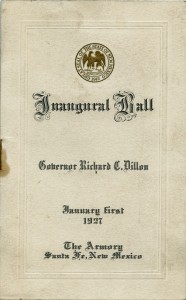 The museum’s Collections Committee had its monthly meeting this morning and, among other businesses, accepted a piece of 1927 ephemera from Gov. Richard C. Dillon’s Inaugural Ball. It’s a neat little six-page affair, about 3 1/2 x 5 1/2 inches, with an honest-to-goodness sign-yourself-up dance card in the middle.
The museum’s Collections Committee had its monthly meeting this morning and, among other businesses, accepted a piece of 1927 ephemera from Gov. Richard C. Dillon’s Inaugural Ball. It’s a neat little six-page affair, about 3 1/2 x 5 1/2 inches, with an honest-to-goodness sign-yourself-up dance card in the middle.
(Whoever the previous owner was, he wasn’t exactly Fred Astaire. Only four of 24 dances were taken, two One Steps, one Two Step and one Foxtrot. Left undanced were, among others, the Varsoviana, the Valencia, the Spanish Waltz and the Charleston.)
Nancy M. Tucker, an Albuquerque resident, provided the inaugural program to us via her regular wanderings about the offerings on the Internet. We have a number of “angels” like Nancy out there, some of the bona fide pickers, some of them folks who just have an interest in history and particularly New Mexico history.
Dillon’s Inaugural Ball was held at the Palace of the Governors and the National Guard Armory, a building that used to be north of the Palace and is now occupied by the New Mexico History Museum. According to the program, some of the luminaries involved in the organization of the event were Gov. Arthur T. Hannett, Arthur Seligman, Miguel A. Otero Jr., Nathan Jaffa, and Archbishop A. T. Daeger. Decorations festooned the Palace and Armory, along with the Capitol (today’s Bataan Building), and the Museum of Fine Art. Norman L. King served as the parade’s grand marshall.
To anyone familiar with New Mexico history, the plethora of names listed among the other committeepeople who helped with the inaugural reads like a who’s who of 1920s Santa Fe and New Mexico. Among them: John Meem, Oscar Huber, Mrs. Ashley Pond, Mrs. N.B. Laughlin, Mr. and Mrs. Henry Dendahl, and Mr. and Mrs. John N. Zook.
 Dillon, a Republican, was the eighth post-statehood governor of New Mexico. According to the National Governors Association, he “was born in St. Louis, Missouri, on June 24, 1877. His early education was attained in the common schools of his native state. He later attended the public schools in Springer, New Mexico, where his family moved in 1889. Before entering politics, Dillon worked as a railroad laborer and a merchant.
Dillon, a Republican, was the eighth post-statehood governor of New Mexico. According to the National Governors Association, he “was born in St. Louis, Missouri, on June 24, 1877. His early education was attained in the common schools of his native state. He later attended the public schools in Springer, New Mexico, where his family moved in 1889. Before entering politics, Dillon worked as a railroad laborer and a merchant.
“In 1924, he won election to the New Mexico State Senate, a position he held two years. Dillon next secured the Republican gubernatorial nomination, and was elected governor by popular vote on November 2, 1926. He was reelected to a second term in 1928.
“During his tenure, the Carlsbad Caverns were declared a national monument by the federal government; and the state government was managed in an efficient, business-like method. After leaving the governorship, Dillon retired from political life. He stayed active in his business career, and eventually established the R.C. Dillon Company. Governor Richard C. Dillon passed away on January 5, 1966, and was buried in Encino, New Mexico.”
I am an american!
The Golden Rule is my rule!
In humility and with gratitude
I acknowledge my undying debt
To the founding fathers
Who left me a pricess heritage … (it goes on for another 24 lines and four exclamation marks.)
Among the other artifacts the Museum is fortunate to have in its collections from Gov. Dillon’s time are an oil-painted portrait, a suitcase, and a 1929 yellow-and-red NM license plate with a big number 1 on it, below the word “Governor.”
The museum is grateful to the many people who keep us in mind when they come upon items that help us tell the story of who we were and who we are. If you think you might have something of interest, give us a call and let’s have a chat.
